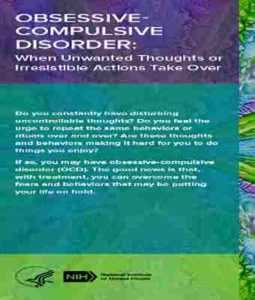Obsessive-Compulsive Disorder: When Unwanted Thoughts or Irresistible Actions Take Over
Do you constantly have disturbing uncontrollable thoughts? Do you feel the urge to repeat the same behaviors or rituals over and over? Are these thoughts and behaviors making it hard for you to do things you enjoy? If so, you may have obsessive-compulsive disorder (OCD). The good news is that, with treatment, you can overcome the fears and behaviors that may be putting your life on hold.
What is it like to have obsessive-compulsive disorder (OCD)?
“I couldn’t do anything without my rituals. They invaded every aspect of my life. Counting really bogged me down. I would wash my hair three times because three was a good luck number for me. It took me longer to read because I’d have to count the lines in a paragraph. When I set my alarm at night, I had to set it to a time that wouldn’t add up to a ‘bad’ number.”
“Getting dressed in the morning was tough because I had to follow my routine or I would become very anxious and start getting dressed all over again.” I always worried that if I didn’t follow my routine, my parents were going to die. These thoughts triggered more anxiety and more rituals. Because of the time I spent on rituals, I was unable to do a lot of things that were important to me. I couldn’t seem to overcome them until I got treatment.”
What is obsessive-compulsive disorder (OCD)?
Obsessive-compulsive disorder (OCD) is a common, chronic (long-lasting) disorder in which a person has uncontrollable, reoccurring thoughts (obsessions) and behaviors (compulsions) that he or she feels the urge to repeat over and over in response to the obsession.
While everyone sometimes feels the need to double check things, people with OCD have uncontrollable thoughts that cause them anxiety, urging them to check things repeatedly or perform routines and rituals for at least 1 hour per day. Performing the routines or rituals may bring brief but temporary relief from the anxiety. However, left untreated, these thoughts and rituals cause the person great distress and get in the way of work, school, and personal relationships.
What are the signs and symptoms of obsessive-compulsive disorder (OCD)?
People with OCD may have obsessions, compulsions, or both. Some people with OCD also have a tic disorder. Motor tics are sudden, brief, repetitive movements, such as eye blinking, facial grimacing, shoulder shrugging, or head or shoulder jerking. Common vocal tics include repetitive throat-clearing, sniffing, or grunting sounds.
Obsessions may include:
- Fear of germs or contamination
- Fear of losing or misplacing something
- Worries about harm coming towards oneself or others
- Unwanted and taboo thoughts involving sex, religion, or others
- Having things symmetrical or in perfect order
Compulsions may include:
- Excessively cleaning or washing a body part
- Keeping or hoarding unnecessary objects
- Ordering or arranging items in a particular, precise way
- Repeatedly checking on things, such as making sure that the door is locked or the oven is off
- Repeatedly counting items
- Constantly seeking reassurance
What causes obsessive-compulsive disorder (OCD)?
OCD may have a genetic component. It sometimes runs in families, but no one knows for sure why some family members have it while others don’t. OCD usually begins in adolescence or young adulthood, and tends to appear at a younger age in boys than in girls. Researchers have found that several parts of the brain, as well as biological processes, play a key role in obsessive thoughts and compulsive behavior, as well as the fear and anxiety related to them. Researchers also know that people who have suffered physical or sexual trauma are at an increased risk for OCD.
Some children may develop a sudden onset or worsening of OCD symptoms after a streptococcal infection; this post-infectious autoimmune syndrome is called Pediatric Autoimmune Neuropsychiatric Disorder Associated with Streptococcal Infections (PANDAS). Learn more about PANDAS at www.nimh.nih.gov (search term: PANDAS).
How is obsessive-compulsive disorder (OCD) treated?
The first step is to talk with your doctor or health care provider about your symptoms. The clinician should do an exam and ask you about your health history to make sure that a physical problem is not causing your symptoms. Your doctor may refer you to a mental health specialist, such as a psychiatrist, psychologist, social worker, or counselor for further evaluation or treatment.
OCD is generally treated with cognitive behavior therapy, medication, or both. Speak with your mental health professional about the best treatment for you.
Cognitive behavioral therapy (CBT)
In general, CBT teaches you different ways of thinking, behaving, and reacting to the obsessions and compulsions.
Exposure and Response Prevention (EX/RP) is a specific form of CBT which has been shown to help many patients recover from OCD. EX/RP involves gradually exposing you to your fears or obsessions and teaching you healthy ways to deal with the anxiety they cause.
Other therapies, such as habit reversal training, can also help you overcome compulsions.
For children, mental health professionals can also identify strategies to manage stress and increase support to avoid exacerbating OCD symptoms in school and home settings. For more information on CBT and EX/RP, please visit http://www.nimh.nih.gov/ (search term: psychotherapies).
Don’t give up on treatment too quickly. Both psychotherapy and medication can take some time to work. While there is no cure for OCD, current treatments enable most people with this disorder to control their symptoms and lead full, productive lives. A healthy lifestyle that involves relaxation and managing stress can also help combat OCD. Make sure to also get enough sleep and exercise, eat a healthy diet, and turn to family and friends whom you trust for support.
Publication Credit: Website: http://www.nimh.nih.gov
U.S. DEPARTMENT OF HEALTH AND HUMAN SERVICES Website: http://www.nimh.nih.gov
National Institutes of Health
NIH Publication No. TR 16-4676
Revised 2016
